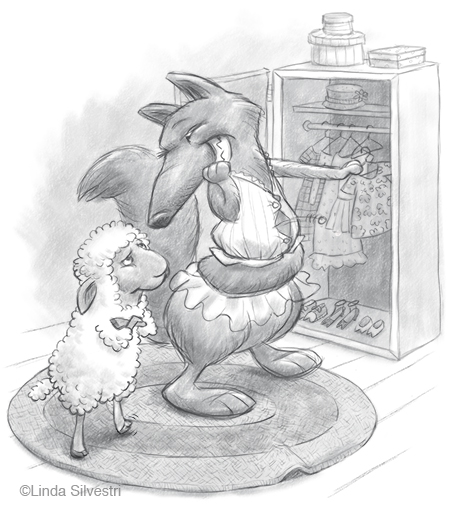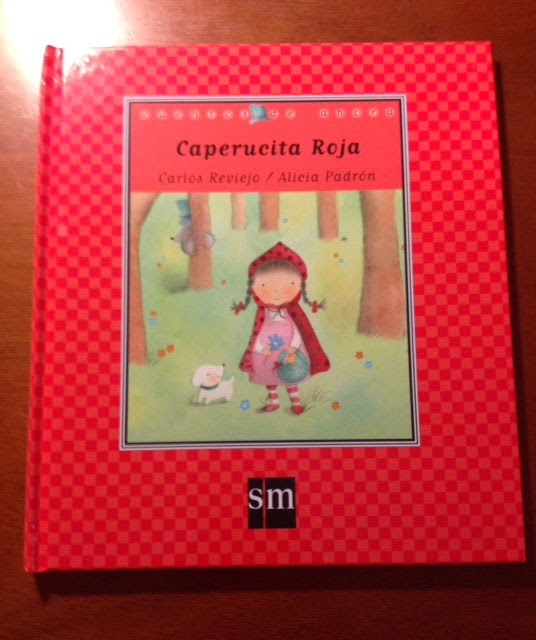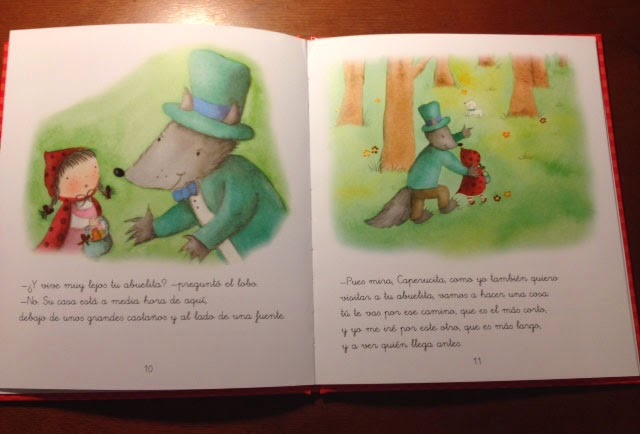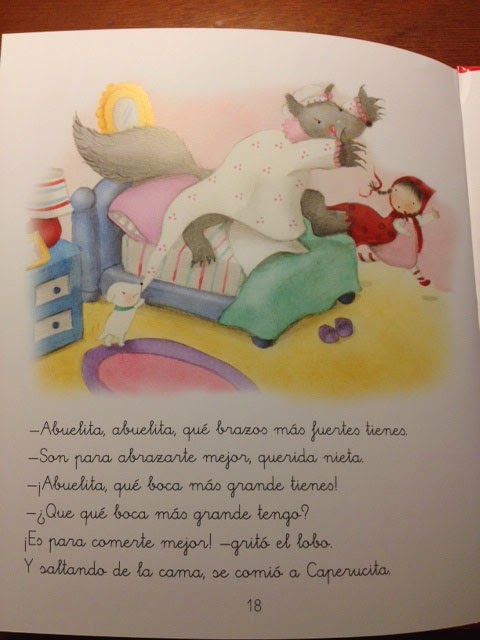Viewing: Blog Posts Tagged with: Wolf, Most Recent at Top [Help]
Results 1 - 25 of 38
Blog: drawboy's cigar box (Login to Add to MyJacketFlap)
JacketFlap tags: fairy tale, wolf, illustration friday, wood, trees, red riding hood, Patrick Girouard, Drawboy, Add a tag
Blog: Illustrator Kim Sponaugle's Picture Kitchen Studio (Login to Add to MyJacketFlap)
JacketFlap tags: SCBWI, wolf, Kim Sponaugle, red riding hood, picture book illustrator, Picture Kitchen Studio, children's book artist, Grimm's fairie tales, Tomie dePaolo contest, Add a tag
A Big Congratulations to the winners of the 2016 SCBWI Tomie dePaolo contest.....Now I can show you my submission, which I had a great time working on, even if it did not make the list!
Check out the winners!
\
Check out the winners of the SCBWI Tomie dePaolo Contest

Blog: PW -The Beat (Login to Add to MyJacketFlap)
JacketFlap tags: Wolf, Announcements, Image, Image Comics, Top News, ted mckeever, Comicraft, Plutona, January 2016, solicits, Add a tag
Who killed the world? Science. Science is the new metal.
Blog: (Login to Add to MyJacketFlap)
JacketFlap tags: wolf, Vikings, spears, wolves, blacksmith, Carole Anne Carr, Saint Cuthbert, anvil, Anglo-Saxons, First Wolf, folk moot, Add a tag
My father growled, wrenching the spear from his brother’s hand. An anxious cry went up, for only the king’s high reeve held the ash spear to decide right from wrong. Then clenching the spear in his fist, as tough as the hammers he used to beat the glowing iron on his anvil, my father gave so threatening a look that the men placed their weapons on the ground, squatting in the sand to listen to him speak.
Blog: The Giant Pie (Login to Add to MyJacketFlap)
JacketFlap tags: Literature, wolf, Fairy Tales, Inspiration, little red riding hood, Terri Windling, Luna Station Quarterly, Catherine Orenstein, Add a tag
My latest column is available at Luna Station Quarterly.
Blog: OUPblog (Login to Add to MyJacketFlap)
JacketFlap tags: History, wolf, Journals, science, alaska, America, endangered species, wolves, extinction, endangered animals, Editor's Picks, *Featured, oxford journals, Science & Medicine, journal of heredity, Earth & Life Sciences, Matt Cronin, North American wolf, Add a tag
Wolves in the panhandle of southeast Alaska are currently being considered as an endangered species by the US Fish and Wildlife Service in response to a petition by environmental groups. These groups are proposing that the Alexander Archipelago wolf (Canis lupus ligoni) subspecies that inhabits the entire region and a distinct population segment of wolves on Prince of Wales Island are threatened or endangered with extinction.
Whether or not these wolves are endangered with extinction was beyond the scope of our study. However our research quantified the genetic variation of these wolves in southeast Alaska which can contribute to assessing their status as a subspecies.
Because the US Endangered Species Act (ESA) defines species as “species, subspecies, and distinct population segments”, these categories are all considered “species” for the ESA. Although this definition is not consistent with the scientific definition of species it has become the legal definition of species for the ESA.
Therefore we have two questions to consider:
- Are the wolves in southeast Alaska a subspecies?
- Are the wolves on Prince of Wales Island a distinct population segment?
The literature on subspecies and distinct population segment designation is vast, but it is important to understand that subspecies is a taxonomic category, and basically refers to a group of populations that share an independent evolutionary history.
Taxonomy is the science of biological classification and is based on evolutionary history and common ancestry (called phylogeny). Species, subspecies, and higher-level groups (e.g, a genus such as Canis) are classified based on common ancestry. For example, wolves and foxes share common ancestry and are classified in the same family (Canidae), while bobcats and lions are classified in a different family (Felidae) because they share a common ancestry that is different from foxes and wolves.

Subspecies designations are often subjective because of uncertainty about the relationships among populations of the same species. This leads many scientists to reject or ignore the subspecies category, but because the ESA is the most powerful environmental law in the United States the analysis of subspecies is of great practical importance.
Our results and other research showed that the wolves in Southeast Alaska differed in allele frequencies compared to wolves in other regions. Allele frequencies reflect the distribution of genetic variation within and among populations. However, the wolves in southeast Alaska do not comprise a homogeneous population, and there is as much genetic variation among the Game Management Units (GMU) in southeast Alaska as there is between southeast Alaska and other areas.
Our research data showed that the wolves in southeast Alaska are not a homogeneous group, but consist of multiple populations with different histories of colonization, isolation, and interbreeding. The genetic data also showed that the wolves on Prince of Wales Island are not particularly differentiated compared to the overall differentiation in Southeast Alaska and do not support designation as a distinct population segment.
The overall pattern for wolves in southeast Alaska is not one of long term isolation and evolutionary independence and does not support a subspecies designation. Other authors, including biologists with the US Fish and Wildlife Service, also do not designate wolves in southeast Alaska as a subspecies and there is general recognition that North America wolf subspecies designations have been arbitrary and are not supported by genetic data.
There is growing recognition in the scientific community of unwarranted taxonomic inflation of wildlife species and subspecies designations to achieve conservation goals. Because the very nature of subspecies is vague, wildlife management and conservation should focus on populations, including wolf populations. This allows all of the same management actions as proposed for subspecies, but with increased scientific rigor.
Headline image credit: Alaskan wolf, by Douglas Brown. CC-BY-NC-SA-2.0 via Flickr.
The post Are wolves endangered with extinction in Alaska? appeared first on OUPblog.
Blog: Aris blog (Login to Add to MyJacketFlap)
JacketFlap tags: wolf, woods, children's art, watercolor, tales, red riding hood, cappuccetto rosso, illustration, Add a tag
Blog: warrior princess dream (Login to Add to MyJacketFlap)
JacketFlap tags: halloween, wolf, watercolor, witch, vampire, etsy, wolves, goth, art print, old work, dark art, Add a tag
 |
| Raven's Eve - 2005 |
Grab this Special Edition print on my Etsy shop: https://www.etsy.com/listing/204576124/halloween-wolf-art-print-full-moon
She will be available until my birthday on November 19, 2014.
RAVEN is a character I designed in high school, who followed me all the way out of college. She was created after viewing the movie "The Crow", and was my way to express the depression and loneliness I was feeling at the time. Most teens do. Since her beginning she has come a long way.
Raven lost everything very young, including her soul. She spent years searching for purpose, looking for a way to fill the void within her heart, but finds no relief. She is immortal, but not fully vampire. She was human, but now there isn't a word for what she is. Raven has been a hired assassin...as her void and depression allow her to null out the emotions, and she has fought for justice as well. She is neither good or evil.
This character is no longer needed in my life. I found the missing piece I was searching for, and it was and is Jesus. Love. When I painted this piece I was starting to transition from a practicing witch to a practicing follower of Christ. Surprisingly, it wasn't that big of a leap for me, as my story led perfectly into His.
The piece RAVEN'S EVE symbolizes her strength and confidence in who she is at the time she was painted. The wolves symbolizing gentleness, wisdom, and maybe some purity. The daggers...well....we all sin every day and they represent that. But also death, death to the old self...the self that has already been dead for so long.
Blog: OUPblog (Login to Add to MyJacketFlap)
JacketFlap tags: christopher betts, jean de la fontaine, selected fables, the fisherman and the little fish, the lion and the fly, the wolf in shepherd's clothing, betts, smock, fontaine, Literature, aesop's fables, Humanities, *Featured, wolf, fables, sheep, bagpipes, french literature, Add a tag
Jean de La Fontaine’s verse fables turned traditional folktales into some of the greatest, and best-loved, poetic works in the French language. His versions of stories such as ‘The Wolf in Shepherd’s Clothing’ and ‘The Lion and the Fly’ are witty and sophisticated, satirizing human nature in miniature dramas in which the outcome is unpredictable. The behaviour of both animals and humans is usually centred on deception and cooperation (or the lack of it), as they cheat and fight each other, arguing about life and death, in an astonishing variety of narrative styles. To get a flavour of the fables, here are two taken from Selected Fables by Jean de La Fontaine, translated by Christopher Betts.
The Wolf in Shepherd’s Clothing
A wolf had hunted sheep from local fields,
but found the hunt was giving lower yields.
He thought to take a leaf from Reynard’s book:
disguise himself by changing what he wore.
He donned a smock, and took a stick for crook;
the shepherd’s bagpipes too he bore.
The better to accomplish his design,
he would have wished, had he been able,
to place upon his hat this label:
‘My name is Billy and these sheep are mine.’
His alterations now complete,
he held the stick with two front feet;
then pseudo-Billy gently stepped
towards the flock, and while he crept,
upon the grass the real Billy slept.
His dog as well was sound asleep,
his bagpipes too, and almost all the sheep.
The fraudster let them slumber where they lay.
By altering his voice to suit his dress,
he meant to lure the sheep away
and take them to his stronghold in the wood,
which seemed to him essential to success.
It didn’t do him any good.
He couldn’t imitate the shepherd’s speech;
the forest echoed with his wolfish screech.
His secret was at once undone:
his howling woke them, every one,
the lad, his dog, and all his flock.
The wolf was in a sorry plight:
amidst the uproar, hampered by his smock,
he could not run away, nor could he fight.
Some detail always catches rascals out.
He who is a wolf in fact
like a wolf is bound to act:
of that there ’s not the slightest doubt.
The Fisherman and the Little Fish
A little fish will bigger grow
if Heaven lets it live; but even so
to set one free, and wait until it’s fat,
then try again: I see no sense in that;
I doubt that it will let itself be caught.
An angler at the river’s edge one day
had hooked a carp. ‘A tiddler still,’ he thought,
but then reflected, looking at his prey:
‘Well, every little helps to make a meal,
perhaps a banquet; in the creel
is where you’ll go, to start my store.’
As best it could, the fish replied:
‘What kind of meal d’you think that I’ll provide?
I’d make you half a mouthful, not much more.
I’ll grow much bigger if you throw me back;
then catch me later on; I’d fill a sack.
A full-grown carp’s a fish that you can sell;
some greedy businessman will pay you well.
But now, you’d need a hundred fish
the size that I am now, to fill a single dish.
Besides, what sort of dish? Hardly a feast.’
‘No feast? quite so,’ replied the man;
‘it’s something, though, at least.
You prate as well as parsons can,
my little friend; but though you talk a lot
this evening it’s the frying-pan for you.’
A bird in the hand, as they say, is worth two
in the bush; the first one is certain, the others are not.
Jean de La Fontaine (1621-95) followed a career as a poet after early training for the law and the Church. He came under the wing of Louis XIV’s Finance Minister, Nicolas Fouquet, and later enjoyed the patronage of the Duchess of Orléans and Mme de La Sablière. His Fables were widely admired, and he was already regarded in his lifetime as one of the greatest poets of his age. Christopher Betts was Senior Lecturer in the French Department at Warwick University. In 2009 he published an acclaimed translation of Perrault’s The Complete Fairy Tales with OUP.
Subscribe to the OUPblog via email or RSS.
Subscribe to only literature articles on the OUPblog via email or RSS.
Image credit: Both images are from Gustave Doré’s engravings, which are included in the edition, and are in the public domain.
The post Selected fables about wolves and fishermen appeared first on OUPblog.
Blog: My place over the hill (Login to Add to MyJacketFlap)
JacketFlap tags: Picturebooks, ediciones sm, caperucita roja, children's books, Wolf, children's illustration, little red riding hood, Add a tag
First thing I decided to do is give Little Red a puppy. He is smart and unlike Little Red, he is suspicious of strangers. I thought it would give a clue to little kids reading the book. Believe me, kids always notice the tiny details.
I wanted wolf to have clothes and look like a "normal" fellow. The point of this story is to show that even normal looking strangers could be dangerous. So Wolf is wearing a top hat, jacket and a bow tie. Bit sofisticated fellow huh? ;o)
These two are my favorite illustrations in the book. :o)
It was a challenge to follow the story and not illustrate too dark or scary. I always like to think of my audience, in this case is very little kids.
And grandma was so much fun to illustrate, hehe!
I have to thank my editor Teresa for always believing in me and giving me complete free range. This is what all illustrators dream of having.. and I can't thank her enough for trusting me with all books we work on.
If you'd like to purchase Caperucita Roja it will be available March 5th. :o)
Blog: sketched out (Login to Add to MyJacketFlap)
JacketFlap tags: animal idioms, lamb, idiom, clothing, animal idiom, wolf in sheep's clothing, illustration, wolf, drawing, humor, sketch, children's illustration, doodle, sheep, sketchbook, sketching, Add a tag
 Sheila finally solved the mystery of that wet dog smell in her closet.
Sheila finally solved the mystery of that wet dog smell in her closet.
Felt like it was time for a nice animal idiom.
“Wolf in Sheep’s Clothing:
One would use this idiom to describe a person or thing appearing to be good but is, well, not so much. There seems to be a few different ideas about it’s origin, but here is what Wikipedia has to say about it.
Blog: Creative Whimsies (Login to Add to MyJacketFlap)
JacketFlap tags: wolf, pigs, sketching, Blog Hop, collage painting, Tomie DePaola award, pigs in a car, Add a tag
Blog: Creative Whimsies (Login to Add to MyJacketFlap)
JacketFlap tags: picture book, wolf, pig, sketch, kid, Add a tag
Blog: OUPblog (Login to Add to MyJacketFlap)
JacketFlap tags: domestication, Crufts, david macdonald, encyclopedia of mammals, Westminster Kennel Club, canids, packs, wolf, dogs, oupblog, wolves, dog show, *Featured, Environmental & Life Sciences, Science & Medicine, American Kennel Club, Add a tag
The 11th of February marks the opening of Westminster Kennel Club’s 137th Annual All Breed Dog Show. First held in 1877, the Westminster Kennel Club Dog Show is America’s second-longest continuously held sporting event, behind only the Kentucky Derby. The Westminster Dog Show epitomizes our long-standing tradition of domestication of dogs, but how did we arrive at such a moment in human and dog relations? The Encyclopedia of Mammals, edited by David MacDonald, offers some explanation as to how this species went from being wild prey-hunters to “best in show,” and from defending territories to defending last year’s titles.
The Dog Family
 Canids originated in North America during the Eocene (55–34 million years ago), from which five fossil genera are known.
Canids originated in North America during the Eocene (55–34 million years ago), from which five fossil genera are known.
Canids evolved for fast pursuit of prey in open grasslands, and their anatomy is clearly adapted to this life. Although the 36 species and 13 genera vary in size from the tiny fennec fox to the large gray wolf, all but one have lithe builds, long bushy tails, long legs, and digitigrade, four‐toed feet with nonretractile claws.
Life in the Pack
The most striking feature of the canids is their opportunistic and adaptable behavior. This is most evident in the flexible complexity of their social organization. Remarkably, there is in this respect almost as much variation within as between species. Though African wild dogs, and possibly dholes and bush dogs, almost always hunt in packs, gray wolves, coyotes, and jackals feed on prey ranging from ungulates to berries. Partly as a result, they lead social lives that vary from solitary to sociable – gray wolves may live in isolated monogamous pairs, or in packs of up to 20 members.
These species, and some others like red and arctic foxes, live in groups even where large prey does not abound and where they hunt alone. Indeed, there are many other reasons for group living – cooperative defense of territories or large carcasses, communal care of offspring, rivalry with neighboring groups. This is clearly illustrated by the Ethiopian wolf, which lives in packs but almost never hunts cooperatively, its prey being largely rodents.
Dogs under Threat
For all their adaptability, members of the dog family cannot escape the indirect threat of habitat destruction. The small‐eared dog and the bush dog are seen so rarely that there are fears for their futures. The Ethiopian wolf numbers some 500 individuals, the African wild dog 5,000 individuals, and the maned wolf a few thousand in its Argentine and Brazilian strongholds. These species are all threatened. The plight of the sociable canids is especially intense insofar as they are victims of the so‐called Allee Effect – that is, at low numbers they enter a downward spiral to extinction. African wild dogs depend on cooperation, so packs with fewer than about five members enter a vortex of decline because they are too small to simultaneously hunt, defend kills, and babysit. Thus, the African wild dogs are even more threatened than their population of 5,000 might suggest, this being equivalent to no more than 700 viable packs across the continent.
Domestication
 Various origins have been proposed for domestic dogs, and doubtless many different canids have been partly domesticated at one time or another. Even so, the wolf is generally accepted as the most likely ancestor of today’s domestic dogs. Domestic dogs are thus known to science as a subspecies of wolf – Canis lupus familiaris. The earliest known archaeological indication of domestication comes from a single canine jawbone unearthed at a site in Germany. More foreshortened than that of a wolf, with the teeth more closely packed together, this find is thought to be around 14,000 years old. Other early remains of what are believed to be domestic dogs include a specimen from Coon in Iran, which dates back over 11,000 years. These various discoveries demonstrate that the wolf entered into domestic partnership with man before any other animal species and before the cultivation of plants for food. Indeed, recent molecular evidence suggests that dogs may even have been domesticated as much as 100,000 years ago.
Various origins have been proposed for domestic dogs, and doubtless many different canids have been partly domesticated at one time or another. Even so, the wolf is generally accepted as the most likely ancestor of today’s domestic dogs. Domestic dogs are thus known to science as a subspecies of wolf – Canis lupus familiaris. The earliest known archaeological indication of domestication comes from a single canine jawbone unearthed at a site in Germany. More foreshortened than that of a wolf, with the teeth more closely packed together, this find is thought to be around 14,000 years old. Other early remains of what are believed to be domestic dogs include a specimen from Coon in Iran, which dates back over 11,000 years. These various discoveries demonstrate that the wolf entered into domestic partnership with man before any other animal species and before the cultivation of plants for food. Indeed, recent molecular evidence suggests that dogs may even have been domesticated as much as 100,000 years ago.
The precise circumstances of domestication have been the subject of considerable speculation. Various theories have been advanced that center on our ancestors’ deliberate use of wolves for practical purposes: hunting, guarding, tidying carrion and refuse around settlements, or even as food items. However, it is equally likely that domestication simply came about by accident, with hunter–gatherer societies capturing and raising young wild animals as pets.
Adapted from the entry on the ‘Dog Family’ in The Encyclopedia of Mammals edited by David MacDonald, also available online as part of Oxford Reference. Copyright © Brown Bear Books 2013. David MacDonald is Founder and Director of Oxford University’s Wildlife Conservation Research Unit.
Subscribe to the OUPblog via email or RSS.
Subscribe to only articles about environmental and life sciences on the OUPblog via email or RSS.
Image credit: Photos via iStockphoto
The post The dog: How did it become man’s best friend? appeared first on OUPblog.
Blog: Library Goddesses Picture Books (Login to Add to MyJacketFlap)
JacketFlap tags: wolf, fables, lying, Add a tag

Blog: Library Goddesses Picture Books (Login to Add to MyJacketFlap)
JacketFlap tags: storytelling, three little pigs, wolf, fractured fairy tales, literary characters, gingerbread boy, Add a tag

Blog: Library Goddesses Picture Books (Login to Add to MyJacketFlap)
JacketFlap tags: wolf, trickster tale, bruh rabbit, Add a tag
Blog: Jessica Lanan Illustration (Login to Add to MyJacketFlap)
JacketFlap tags: Illustration, animal, book, wolf, children's, watercolor, Add a tag
Happy Monday! Here’s a quick watercolor to start off the week. This is a wolf I met at a place called Mission Wolf.
Add a CommentBlog: Sugar Frosted Goodness (Login to Add to MyJacketFlap)
JacketFlap tags: wolf, mirror, pocket mirror, keri dawn studios, Girl, Add a tag
Hi All
Just wanted to let you know I have opened up an Etsy store called Keri Dawn Studios. I will be selling pocket mirrors, prints, pins, magnets, etc with my illustrations, drawings and designs on them. Take a look and let me know what you think. Here are a few samples of the mirrors:
Here is the link to my store:
http://www.etsy.com/shop/keridawnstudios
Thanks for looking!!
Keri
Blog: Gigi's Studio (Login to Add to MyJacketFlap)
JacketFlap tags: woods, little red riding hood, promotional, trees, flower, whimsical, fog, foggy, in from my studio, animal, Illustrations, children's illustration, digital, Children's Illustrations, dark, fairytale, basket, In From My Studio…, illustrator, food, girl, wolf, flowers, photoshop, nature, people, Add a tag
After some back and forth, I finally dececided on the illustration I wanted to use as my new promo postcard. I finished this piece in the wee hours of Monday morning. I was kind of surprised I sat here Sunday night and worked on this. I rarely paint on Sunday […]
Blog: Watercolor Wednesdays (Login to Add to MyJacketFlap)
JacketFlap tags: wolf, Bird, goat, Fox, Lemur, kudo, Julie Hammond, animals of Israel, Add a tag
Blog: Ginger Pixels (Login to Add to MyJacketFlap)
JacketFlap tags: Ginger Nielson, Peter, duck, afterwards, wolf, Add a tag
Blog: studio lolo (Login to Add to MyJacketFlap)
JacketFlap tags: fairy tale, wolf, illustration friday, woods, forest, red riding hood, studio lolo, Add a tag
Blog: studio lolo (Login to Add to MyJacketFlap)
JacketFlap tags: studio lolo, six word saturday, wolf, Add a tag
Blog: Monday Artday (Login to Add to MyJacketFlap)
JacketFlap tags: wolf, jennifer lea, aesops fables, i-love-rabbits.blogspot.com, Add a tag
View Next 12 Posts
























Best enterprise publications.
McKeever actually did both Miniature Jesus in 2013 and The Superannuated Man in 2015 for Image. Check ’em out!
While Image’s biggest handicap is the lack of an editorial focus, their commitment to publishing comics can’t be denied. Hopefully, fans will respond, and the big two will have some market competition at last!